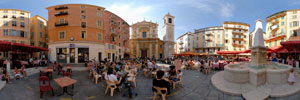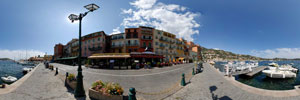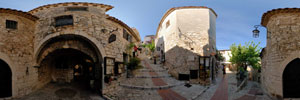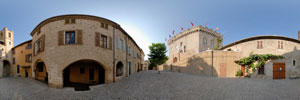Nice Panorama
- News :
- French Riviera :
- Provence :
- Var :
- Leisure :
- Economy :
- Gastronomy :
- Sport :
- Accommodation :
- Tourism :
- Site Map :
Nice’s region on the French Riviera : a virtual visit
Nice
, Prefecture of the Alpes-Maritimes, is the fifth largest city in France. Nice is the center of an urban area of more than 930 000 inhabitants. This vibrant city has many commodities as the second airport in France (nearly 10 millon passengers in 2006), two convention centers and business districts (Nice Arenas). Nice is the second French tourist town after Paris.
Nice is located on the shores of the Mediterranean at the bottom of the Bay of Angels. The city, is housed in a narrow mountain basin supported the Mercantour massif. It is bounded on the west by the Var valley and on the east by the Boron Mount. Several hills overlooking the city. The best known is named Cimiez with its ancient ruins, Chagall and Matisse museums, and old Belle Epoque hotels. Castle Hill separates the old city from the port. The town is crossed by two small torrential rivers: The Paillon on the east and The Magnan on the west.
Nice is famous for its old town, the Cours Saleya which hosts markets and restaurants, Chagall and Matisse museums, Mamac (contemporary art museum) and of course the promenade des Anglais, which stretches from the sylvan theater (outdoor theater) to the airport. The evening, Nice also offers some Jet-Set places (Negresco, many discos).
Villefranche-sur-Mer
is located at the bottom of the bay of Villefranche, formed by the Cape of Nice and Cap Ferrat. Its history is intimately linked to this beautiful bay.
Villefranche-sur-Mer was founded in the 13th century by Charles II of Anjou, Count of Provence, because of the strategic importance of this site, located at the borders of its territory. To encourage people to come repopulate the deserted seaside due to repeated barbarian attacks, the village was granted tax privileges and called because of it Villa Franca (“free port”).
In the 14th century, Villefranche-sur-Mer passes to the Duchy of Savoy. The village is the only seaport of the Alpine duchy and takes income from all merchant ships docking at the port. In the 16th century, following the occupation of the harbor by the Franco-Turkish fleet, commanded by Barbarossa, the Duke of Savoy, Emmanuel Philibert, ordered the fortification of the harbor. It was not until 1860 that the village was annexed to France with the entire County of Nice. The bay of Villefranche-sur-Mer hosted the 6th American naval fleet at the end of the Second World War (between 1945 and 1962). Villefranche-sur-Mer is now the leading cruise port in France.
The walking tour of Villefranche-sur-Mer is nice. It allows you to discover the heritage of the city: St Michael’s Church with its Baroque Italian style built in the 18th century, the chapel of Saint-Pierre, decorated by Jean Cocteau, the “Rue obscure” (or “Dark Street” which is a passage way under the harbour front houses) of the 14th century, and the port of the Darse.
Villefranche-sur-Mer hosts the oceanographic observatory and its 3 laboratories (oceanography, marine geoscience and Cell Biology). The bay of Villefranche-sur-Mer is the site of freediving (apnoe) competitions; the world championships were held there in 2005.
Eze
possesses as numerous villages situated near the seaside an animated history. In the 10th century, after the establishment of the village, Ezasques undergoes the occupation of the Moors. These last ones, established in Fraxinet behind Saint-Tropez, rob the populations of the Southeast during almost eighty years. They will be chased away from the region by Guillaume de Provence at the end of the 10th century.
The castle, built in the course of the 12th century, is seized by the count of Provence, Raymond Béranger V. It will be the property of the crown of Anjou-Provence from the 13th to the 14th century.
In the 14th century, Eze passes at Home of Savoy. Only maritime opening of the realm, the County of Nice presents a strategic interest. The counts of Savoy improve the fortifications of Eze and protect the town with a double strengthened door, the \"Poterne\". The castle undergoes numerous modifications to be adapted to the progress of the artillery.
In the 16th century, the Turkish fleet and it's French ally commanded by Barberousse seize the village. At the beginning of the 18th century, Louis XIV give a decisive blow to the town during the war of succession of Spain by ordering the destruction of the ramparts and castle to remove a possible point of resistance between Villefranche and Monaco.
Nowadays, the visit of the village shows the vestiges of this animated history. The visit of the exotic garden, at feet of the ruins of the castle, offers a very beautiful sight on the Cap Ferrat.
Cagnes-sur-Mer
extends along a bay with almost four miles of beach. The city is surrounded by hills, including the one which hosts the castle and is 90 meters above sea level. Two rivers run through it: the Cagne and the Malvan.
Medieval village in the 11th century it became an important frontier post in the 14th due to its proximity to the Var river which formed the border between Provence and the County of Savoy. The village suffers from numerous border conflicts in the 16th century, and then enjoyed a period of calm in the 17th during the reign of Louis XIII. It underwent further invasions in the 18th century under the reigns of Louis XIV and Louis XV.
Haut de Cagnes: In the early 14th century, Raynier Grimaldi, co-lord of Monaco, became lord of Cagnes-sur-Mer. He built the castle which remains the property of the branch of Grimaldi from Antibes, until the French Revolution. In the 17th century, Jean-Henri Grimaldi decides Honoré II of Monaco to switch from Spanish protectorate to French protection. Swamped with wealth by Louis XIII and Richelieu, he transformed the medieval castle in a comfortable home in which he led a luxurious lifestyle.
The Cros de Cagnes: At the end of the 18th century, fishermen of Menton discovered that the waters of Cagnes are very rich in fish. They decide to settle down on this swampy coast and are quickly joined by inhabitants of Cagnes who abandon their farming activities. The village continues to prosper through fishing reaching its peak in the early 20th century.
Besides the visit of Haut de Cagnes, the city shelters the Renoir domain where the painter Pierre-Auguste Renoir lived from 1903 up to his death in 1919. This domain, today transformed into museum, proposes the visit of the workshop of the painter, the paintings of the pearly period (from 1889 to 1919) and sculptures.
Cagnes-sur-Mer hosts since the mid-20th century the Hippodrome of the French Riviera for horse racing. Infrastructure has continued to grow and improve, making it now one of the largest racetrack in France.
Around Monaco
Around Nice
Around Cannes
Around Grasse



